Morris & Fan. Reservoir Sedimentation Handbook
Подождите немного. Документ загружается.

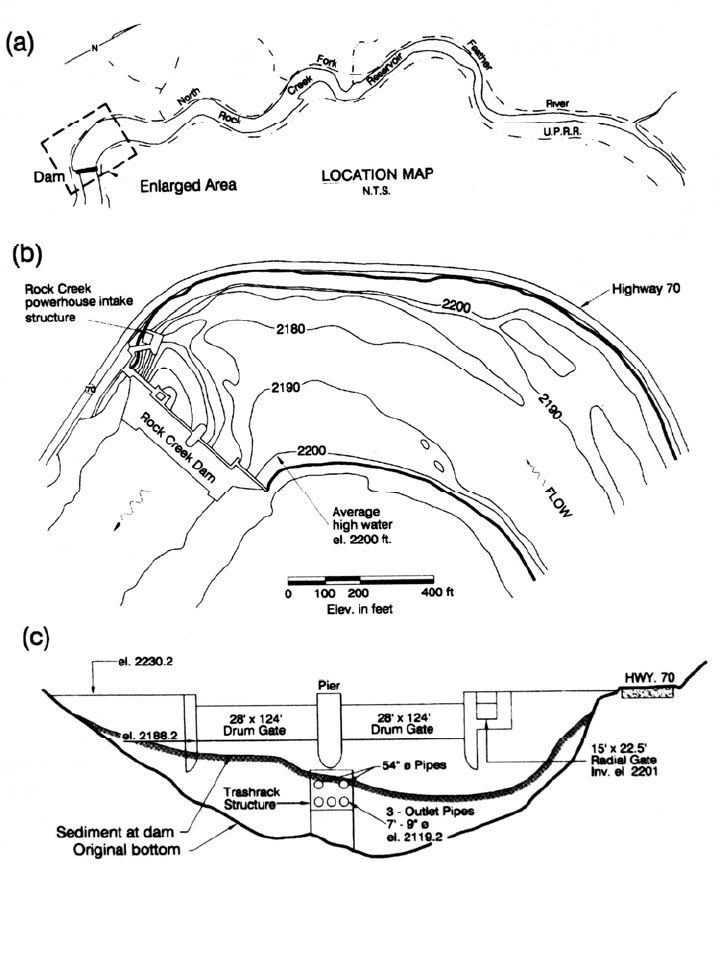
NORTH FORK FEATHER RIVER, CALIFORNIA, USA 22.20
FIGURE 22.9 Rock Creek Reservoir: (a) geometry and (b)
b
athymetry near the dam showing
scour on the exterior of the curve. (c) Configuration of Rock Creek Dam, upstream face,
showing gate arrangement and sediment accumulation. (modified from Planning Associates,
1991).
The proposed dredging project involved the removal of 380,000 m
3
of sediment that
had accumulated in front of the powerhouse tunnel intakes and the low-level outlets at
each dam by a barge-mounted crane with a 7.6-m
3
(10-yd
3
) clamshell bucket. The
sediment was to be loaded onto receiving barges, dewatered, off-loaded onto trucks, and
then hauled over the highway to create an engineered fill at Rogers Flat. The proposed
fill area would cover about 7.5 ha and would be about 21 m tall. Dredging was
anticipated to require 1 year, with an additional 6 months for mobilization and take-
down.
To minimize disturbance to aquatic habitat, the mean daily turbidity level generated
by dredging operations was limited to not more than 25 NTU over ambient, as measured

NORTH FORK FEATHER RIVER, CALIFORNIA, USA 22.21
at designated compliance points downstream of the project. An absolute suspended solids
limit of 80 mg/L (project plus ambient) was also established. Provision was made
for determining suspended solids compliance from turbidity data once the
relationship between NTU and mg/L was established in the field. Several monitoring
stations were specified, including one not more than 90 m downstream of the off-
loading facility on the side of the reservoir with the highest turbidity. Provision was
also made for the release of a flushing flow at the end of the project to remove
sediment from spawning gravels and other important aquatic habitats, in accordance
with procedures previously developed by Bechtel (1987), if recommended by a
qualified independent fisheries biologist or hydrologist qualified in fluvial geomor-
phology.
Sampling of benthic invertebrate populations and streambed sediment accumulation
by Coleman-Haynes substrate samplers was required. Three sampling stations
were specified: a control station in a riffle area upstream of the dams and sites about
300 m downstream of each of the two dams. These samplers were to be left in place for
an 8-week period, removed and inventoried, and a new sampler set out. Sampling
was to begin 8 weeks prior to start of dredging. Data to be reported were substrate
volume, identification and counts of organisms, and dry weight and grain size
distribution of fine sediment collected in the sampler.
Dust was to be controlled on dirt roads by watering, and on the paved road by
sweeping rather than watering to prevent turbid runoff from entering the river. Special
requirements were also established for items such as monitoring a golden eagle nest
near Rock Creek Reservoir, removal of fuel from a crane that had been previously sunk
in Rock Creek Reservoir, protection of riparian vegetation, noise, burning, employee
parking, provision of alternative recreation sites, and cultural resources.
Although the use of large-scale reservoir dredging has been discarded, the installation
of the outlets for sediment pass-through will require that about 103,000 m
3
of
material be dredged from the upstream side of the new outlets. During 1994, a one
month test dredging program was performed in Cresta Reservoir, removing about
8000 m
3
of material from the vicinity of the powerhouse intake while monitoring
water quality parameters (Creek and Sagraves, 1995). The dredging system used in
the test was a submerged slurry pump which suspended sediment by using a strong
hydraulic vortex to draw a water-sediment mixture into the pumping system, rather
than a cutterhead. The system complied with the water quality requirements
established by the California Regional Water Quality Control Board of not more
than 25 NTU turbidity increase or more than 80 mg/L total suspended solids,
absolute. It was concluded that the system was capable of dredging sandy material
without significant water quality impacts.
22.8 SEDIMENT ROUTING
PG&E is preparing to implement sediment pass-through to route the inflowing fluvial
sediments through all three dams along the North Fork of the Feather River,
without scouring and releasing
-
the large volume of the fine sediment which has
accumulated behind the dams over the past 40 years or more. This project seeks to
maintain reliable hydropower operations at Rock Creek and Cresta despite sediment
accumulation. The specific objectives of the sediment management are:
1. Avoid plugging and collapse of trash racks;
2. Restore reliable operation of the primary hydraulic control system for the spillway
drum gates;
NORTH FORK FEATHER RIVER, CALIFORNIA, USA 22.22
3. Reduce sediment-caused turbine wear at powerhouses;
4. Minimize buildup of sediments within drum gate flotation chambers in the dams;
5. Eliminate the need for costly major dredging projects;
6. Eliminate sediment buildup in the vicinity of the power intake and bottom outlets;
7. Maintain long-term storage capacity equivalent to an average pool depth of about 3
m for daily hydropower peaking storage.
Although the dams make it impossible to precisely reestablish the natural (predam)
sediment discharge relationship, sediment routing mimics the natural sediment discharge
relationship more closely than does any other type of sediment management
procedure. A modeling program was undertaken to design the physical and
operational characteristics of the sediment routing required to achieve these
objectives. Modeling procedures are described by Harrison et al. (1995) and Chang
et al. (1995).
The reservoirs will be operated to reestablish, as nearly as possible, the pre-
impoundment pattern of sediment transport along the river. The fines presently trapped
behind the dam should not be released downstream in significant quantities.
However, sediment routing will create a scour cone upstream from each low-level outlet
which would release fine sediment. To prevent this release, the scour cone volume
will be dredged prior to the first flushing event.
22.8.1 Modeling Approach
Sediment passage required that both Rock Creek and Cresta Dams be reconstructed
to incorporate in each dam large low-level outlets that could be opened to reduce the pool
elevation in the reservoir and release sediments. These outlets would be used in
conjunction with the existing low-level outlet pipes. Hydraulic design required two types
of sediment transport modeling activities. Physical modeling was used to
determine the three-dimensional characteristics of the scour hole in the vicinity of
the proposed outlet works and to ensure the outlets had adequate capacity to
discharge sediment under conditions of extreme loading. A one-dimensional
numerical model of the river, including all three dams, was used to develop the
operating rule that would allow a sediment balance to be achieved. Both the
physical and numerical modeling was performed as an iterative process.
22.8.2 Physical Modeling
A 1:50 scale physical model was constructed under the direction of Albert Molinas at
Colorado State University to simulate the downstream plunge pool, dam, and reservoir
bathymetry 460 m upstream of each dam (Fig. 22.10). Polystyrene pellets of
cylindrical shape with specific gravity of 1.04 were used to model sediment with 3-
mm (prototype) grain size. Calibration was performed with data from the 1986
flood.
The physical model was exercised to determine the stage-discharge rating curves
for the existing and each proposed gate configuration, and this relationship was used as
the downstream boundary condition in the reach of the mathematical model
extending upstream from each dam. It was also used to observe the configuration of
flushing cones and the entrainment of sediment near the dam for alternative outlet
configurations. The volume of existing sediment in the anticipated flushing cones
ranged from 25,000 to 40,000 m
3
at Cresta and 10,000 to 31,000 m
3
at Rock Creek.
Sediment in the area of the flushing cones will be dredged out for two reasons: to
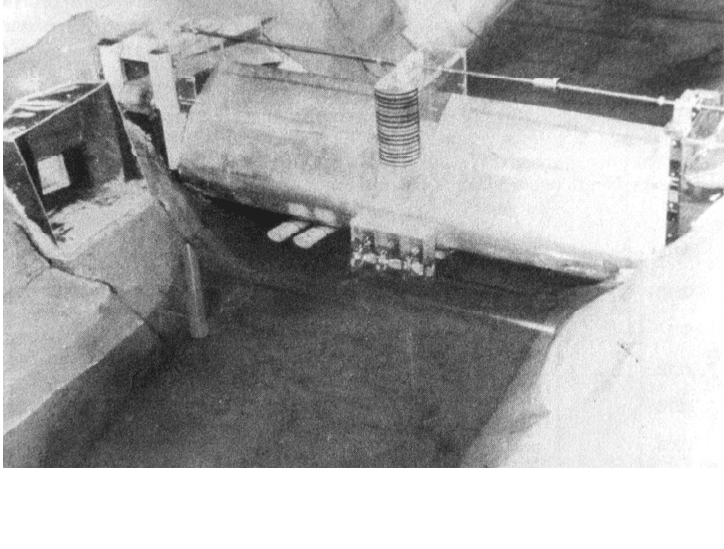
NORTH FORK FEATHER RIVER, CALIFORNIA, USA 22.23
prevent the sudden collapse of sediment when operation begins, and to eliminate the
release of fine sediment into the river downstream of the dams. The dredging volume
will be specified as 50 percent larger than the predicted cone volume to provide a margin
of safety. The modeled flushing cone configuration was determined by the outlet
elevation, exit velocity, outlet size, and sediment angle of repose, and was nearly
independent of the reservoir operating rules tested.
FIGURE 22.10 Physical model of dam at 1:50 scale (W. Lee).
Th
ree types of sensitivity analysis were performed:
1. A sediment wave test simulated an upstream landslide which could potentially bury
low-level outlets.
2. The critical velocity required to produce incipient motion of the sediment bed was
determined to be about 0.76 m/s.
3. Plate tests performed to determine the ability of the flow to induce motion of various
sizes of particles during sediment pass-through events, indicated that gravel up to 17
mm in diameter may be mobilized and transported through the reservoir.
The model was also run with 0.1-mm (model-size) sand to validate the use of
lightweight plastic pellets to simulate reservoir sediments, producing results very similar
to those for plastic pellets.
22.8.3 Numerical Modeling
Numerical modeling of the entire river reach including the three dams was reported by
Chang et al. (1995) and by Chang and Fan (1996) using the FLUVIAL-12 model
described by Chang, 1988. Numerical simulations were used to identify an operating
rule that would produce long-term sediment equilibrium and would also be simple for
the operators to implement. The 1986 flood event was used to calibrate the numerical
model, and validated the use of Yang's formula for both sand and gravel transport. The
calibrated model was then run to test different operating rules with the 30-year historical
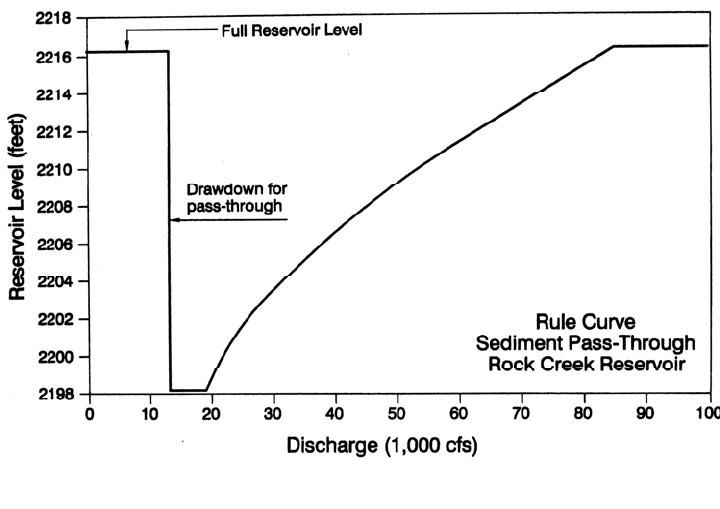
NORTH FORK FEATHER RIVER, CALIFORNIA, USA 22.24
hydrograph, which was compressed by eliminating all discharges less than 57 m
3
/s, since
these had an insignificant impact on sediment transport.
Numerical modeling indicated that discharges of 283 m
3
/s and 368 m
3
/s respectively
were required to initiate effective sediment pass-through at Cresta and Rock Creek. These
discharges have an average return interval of 1.3 years (30 events in 38 years of gage
record). The operating rule curve developed at Rock Creek Reservoir is presented in Fig.
22.11. At discharges below 368 m
3
/s, the reservoir is operated in normal impounding mode
FIGURE 22.11 Operating rule curve proposed at Rock Creek Dam (after Chang et al., 1995).
and power is
produced. When the critical discharge is reached, low-level outlets are
opened as required to achieve and maintain a 5.5-m drawdown until full outlet capacity is
reached, after which the water level rises with increasing discharge. This operational
sequence is reversed during flow recession. The existing drum gates may also be
exercised to achieve the initial drawdown, and power inlets are closed during drawdown
to prevent sediment from entering the turbines. Poe Dam will continuously operate at its
normal pool level.
Because low flows carry little sediment, there will be relatively little accumulation
within the reservoirs between routing events. However, to stabilize storage capacity
there will necessarily be some net export of sediment during a routing event, but its
environmental impact will be minimal because of dilution and the ability of the
sediment pass-through discharge to transport sediment through the downstream channel.
The spatial variation in sediment delivery along a river reach may be visualized by
plotting cumulative sediment delivery over a specified time interval as a function of
distance along the reach (Fig. 22.12). In graphs of this type, if the plotted sediment
delivery line tends upward while moving downstream along the river, this represents
increasing sediment delivery because of the scouring of channel sediment. Declining
sediment delivery, on the other hand, indicates an area of sediment deposition. The
essentially uniform longitudinal plot of sediment delivery along the North Fork Feather
River under the proposed operating rule shows that depositional and erosional processes
along the entire reach, including the reservoirs, are well-balanced in the long term, even
though each reservoir still undergoes periods of net erosion and net deposition at different
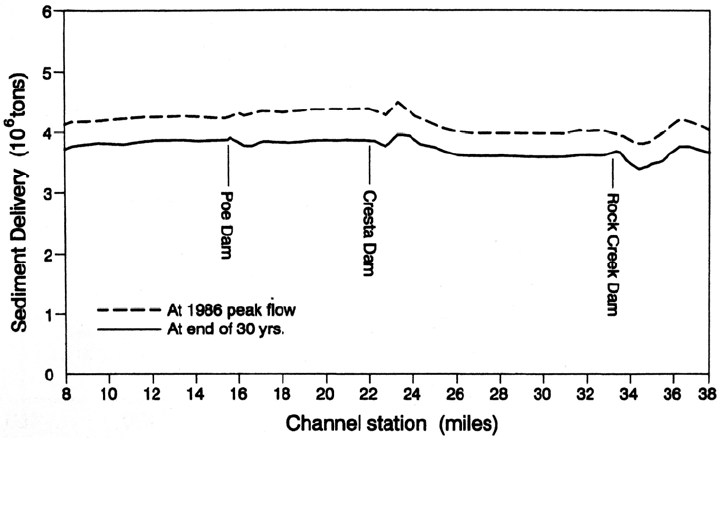
NORTH FORK FEATHER RIVER, CALIFORNIA, USA 22.25
times. One particular feature of the FLUVIAL-12 model is its ability to simulate patterns of
transverse scour, once properly calibrated. This feature enabled the transverse
configuration of the bed in the curved reach of Rock Creek Reservoir upstream of the
dam to be simulated (Fig. 22.13).
FIGURE 22.12 Long-term sediment delivery along North Fork Feather River under the proposed
operating rule (after Chang et al., 1995).
22.8.4 Selected Project Configuration
The project configuration recommended for construction consists of:
1. Installation of a new 5.18-m-diameter low-level outlet pipe at Rock Creek darn;
2. Installation of a new 4.27-m-diameter low-level outlet pipe at Cresta dam;
3. Modification of trash racks at existing low-level outlet pipes at both dams to improve
sediment pass-through;
4. Limited dredging at both reservoirs to excavate scour cones upstream of the new
low-level outlets; and
5. Implementation of sediment pass-through operating rule during high flows. s.
The dredging volumes recommended at Rock Creek and Cresta are 46,000 m
3
and 57,000
m
3
respectively, compared to dredging 382,000 m
3
from each reservoir as previously
planned, and future maintenance dredging is eliminated. It is proposed that dredged
material be discharged into an upstream area of each reservoir from which it would
subsequently be entrained and transported downstream during pass-through operations.
An alternative plan involves trucking of dredged material to Roger's Flat.
The
dredging volumes recommended at Rock Creek and Cresta are 46,000 m
3
and 57,000
m
3
respectively, compared to dredging 382,000 m
3
from each reservoir as previously
planned, and future maintenance dredging is eliminated. It is proposed that dredged
material be discharged into an upstream area of each reservoir from which it would
subsequently be entrained and transported downstream during pass-through operations.
An alternative plan involves trucking of dredged material to Roger's Flat.
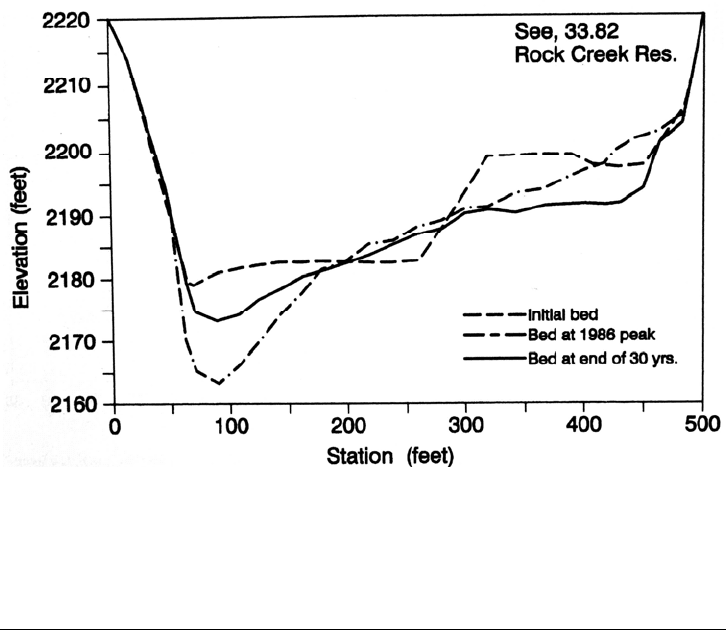
NORTH FORK FEATHER RIVER, CALIFORNIA, USA 22.26
FIGURE 22.13 Simulation of long-term and flood impacts on cross-section geometry in the curved
reach upstream of Rock Creek Dam, view looking upstream (after Chang et al., 1995).
22.9 SEDIMENT PROBLEMS AT POE DAM
Although sediment problems at Poe Dam were insignificant from the standpoint of
hydropower generation, some problems have occurred as a result of environmental
issues. In February of 1988, spillway gates at Poe Reservoir were opened to drawdown
the pool to allow the repair of a leaking gate. Discharge during this release peaked at
about 50 m
3
/s, and as the pool was drawn down it became apparent that a significant
amount of fine sediment was being sluiced from the reservoir and into the river channel
downstream. The gates were closed and drawdown was halted. This action revealed that
the pool immediately downstream of the dam had filled completely with fine sediment,
and two additional pools further downstream had partially filled with fine sediment.
The d
50
grain size decreased moving downstream along the three pools: 0.21 mm, 0.20
mm, and 0.13 mm. Mechanical removal of the fine sediment was considered, but
because of poor access to the two downstream pools and because the sediment was
spread out in a thin layer (less than 0.6 m thick) over a rather large area, mechanical
removal might cause more environmental harm than good.
As an alternative to mechanical removal, the release of clear water to flush 3800 m
3
of sediments downstream into the large Oroville Reservoir about 12 km downstream was
evaluated. Four equations were used to estimate sediment transport as a function of
discharge (Table 22.8). The Meyer-Peter and Muller equation reports only bedload and
underreports total sand transport at larger discharges when much of the sand is
transported as suspended load. The transport values from the other three equations were
averaged to develop a relationship between discharge and transport capacity, which was
then used to estimate the time and water volume required to flush the sediment (Table
22.9). Although a high discharge could quickly remove the sands, it would also flush
spawning gravels out of the system. With spawning-size gravels in limited supply, and
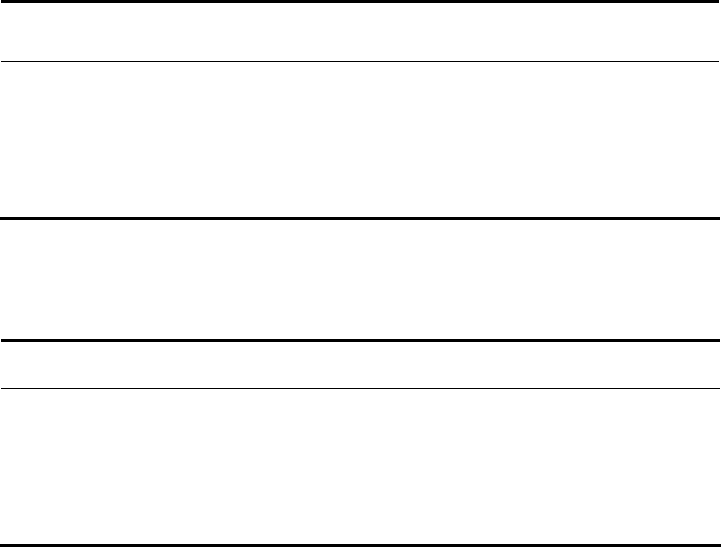
NORTH FORK FEATHER RIVER, CALIFORNIA, USA 22.27
TABLE 22.8 Sediment Transport Capacity, m
3
/s, as a Function of Discharge for Four
Transport Equations
Discharge
m
3
/s
Meyer-Peter
and Muller
Ackers and
White
Brownlie
Engelund
and Hansen
14 24 1 8 8
28 145 57 105 114
57 609 1025 966 1317
85 1258 4176 3094 4815
113 1982 9943 6386 10,555
Source: Ramey (1988).
TABLE 22.9
Flushing Duration and Water Required to Remove 3800 m
3
of Sand
Discharge,
m
3
/3
Average transport
capacity, m
3
/day
Flushing
duration, days
Volume of water
used, 10
6
m
3
14 5 714 874
28 92 42 102
57 1102 3.5 17
85 4025 1.0 7.0
113 8961 0.4 4.2
Source: Ramey (1988).
their resupply being prevented by trapping at the upstream dams, it was important that the
release not further encourage the flushing of this resource out of the river system. The
recommended maximum flushing flow in this case was 70 m
3
/s (2500 ft
3
/s), a discharge
adequate to surficially cleanse gravel deposits without causing major movement of the
gravels themselves (Bechtel, 1990).

CHAPTER 21
CASE STUDY: SEFID-RUD
RESERVOIR, IRAN
23.1 INTRODUCTION
Sefid-Rud Reservoir in Iran demonstrates the implementation of sediment control at a
large 1760-Mm
3
reservoir which has floodplain-foothill (Type II) geometry. The dam
is located on Sefid-Rud River, a tributary to the Caspian Sea, immediately
downstream of the confluence of Qezel Owzan and Shahrud Rivers and about 250 km
northwest of Teheran. The geometry of the watershed and the reservoir, which has
a major and a minor branch, is shown in Fig. 23.1. The reservoir was constructed in
1962 to supply 2800 Mm
3
of regulated flow to irrigate 250,000 ha of rice during a 6-
month summer irrigation season. It also has a 87.5-MW hydropower station.
Sedimentation was a serious problem and caused storage loss at the rate of 36.5
Mm
3
/yr, equivalent to an annual rate of 2.1 percent. Because of rapid storage loss,
in 1980 reservoir operation was changed to incorporate desilting operations following
17 years of conventional operation.
Detailed and comprehensive data on all phases of sediment management at this
reservoir, including flushing and supplemental erosion of deposits by using both
lateral and longitudinal (diversion) channels has been reported by Esmaiel Tolouie
(1989, 1993). These reports, photography, and additional comments kindly
provided by Tolouie, have been the basis for this case study.
23.2 SITE CHARACTERISTICS
23.2.1 Dam and Reservoir
The dam is a buttress-gravity concrete structure with a maximum height of 106 m and a
crest length of 425 m. The installed powerhouse capacity is 87.5 MW and the minimum
hydropower operating level is 240 m. The general configuration of the dam showing
the location of the outlets is presented in Fig. 23.2. There are three bottom outlets
on the right side and two bottom outlets on the left side (looking downstream), with total
combined capacities of 430 m
3
/s and 550 m
3
/s respectively. Bottom outlets are near
the original streambed elevation and the design does not incorporate a dead
storage pool. High-level "morning glory" and auxiliary spillways are also
provided.
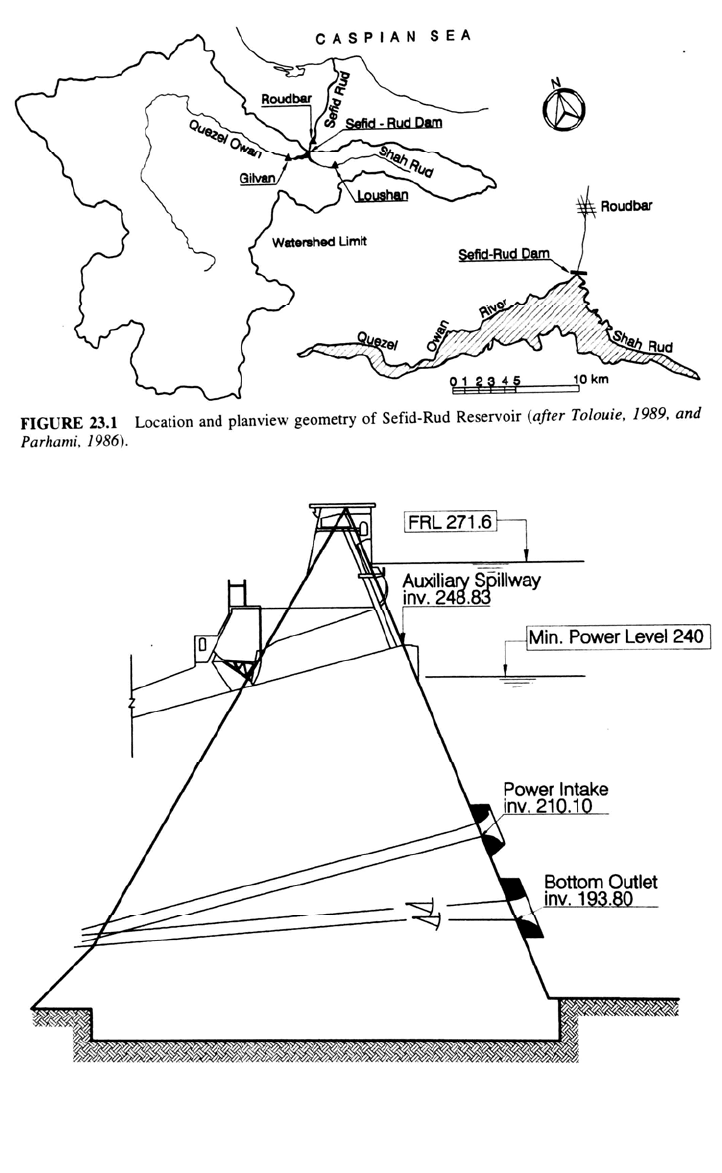
CASE STUDY: SEFID-RUD RESERVOIR, IRAN 23.2
FIGURE 23.2 Section view of Sefid-Rud Darn showing gate locations (after Tolouie,
1989).
